4) Fears and phobias
1/42
There's no tags or description
Looks like no tags are added yet.
Name | Mastery | Learn | Test | Matching | Spaced |
|---|
No study sessions yet.
43 Terms
Phases of an Encounter with a Predator
Detection / Encounter Phase
The animal freezes to avoid being seen by predator
Pursuit and Attack Phase
Predator begins to chase or strike - animal tries to escape, resist, or fight back.
Capture Phase
If unable to escape, animal enters Tonic Immobility (TI).
what is tonic immobility?
characteristics (5)
“animal hypnosis” — an involuntary, temporary state of paralysis or rigidity in response to extreme fear.
Still conscious and processing the environment
Shows loss of pain sensitivity (analgesia)
Physical immobility and muscular rigidity
Eyes closed or fixed/unfocused gaze
Tremors resembling Parkinson’s symptoms
experimental findings of TI:
how is tonic immobility induced in lab?
how is TI impeded/enhanced?
Induced in lab animals by flipping them upside down and gently restraining them until they stop struggling.
Reduced (impeded) if other mobile animals are nearby - as seen w/ chickens
Enhanced (facilitated) by predator cues (e.g., visible eyes).
Triggers and Biological Basis for tonic immobility
triggered by
TI is weaker when ____ and stronger when _____
is it voluntary?
Is it evolustionary acient? why?
Triggered by fear and physical restraint.
Weaker when animals are tranquilized or have amygdala lesions.
Stronger (potentiated) with adrenaline.
Involuntary—occurs only after all voluntary escape actions have failed.
Evolutionarily ancient—found across many animal species.
to get it to happen
trigger it into fear state
tranquilize = reduces TI
amygdala lesion = reduces TI
adrenaline increases T
what is Clinical Relevance of tonic immobility
TI has parallels to human freeze responses in extreme fear or trauma situations (e.g., PTSD or assault victims).
tets on how different experiences affect TI in chickens
Conditions:
INESC: Inescapable shock condition
ESC: Escapable shock condition
Control: No shock
Procedure:
24 hours after exposure, chickens were physically restrained to induce TI.
Tested under three setups:
Other mobile chickens present
Predator eyes visible
Predator eyes covered (with tape)
Measures:
Number of attempts needed to induce TI
Duration of TI
Findings:
INESC group (inescapable shock - chicken that are now more hypervigilant to external stim) was more sensitive to external cues (e.g., predator eyes).
threatening eyes present (see threatening eyes)- only need 1 inversion to induce TI
they are using eyes to evaluate dangerous external cues
eyes absent (cant see threatening eyes) - medium # inversions needed to induce IT
cohort w/ eyes - being around other animals, they see that other animals are ok (external cue of safe environment) → so they believe they are ok too → took most attempts to induce TI
Suggests prior inescapable fear experience increases sensitivity and TI duration 0 longer TI.
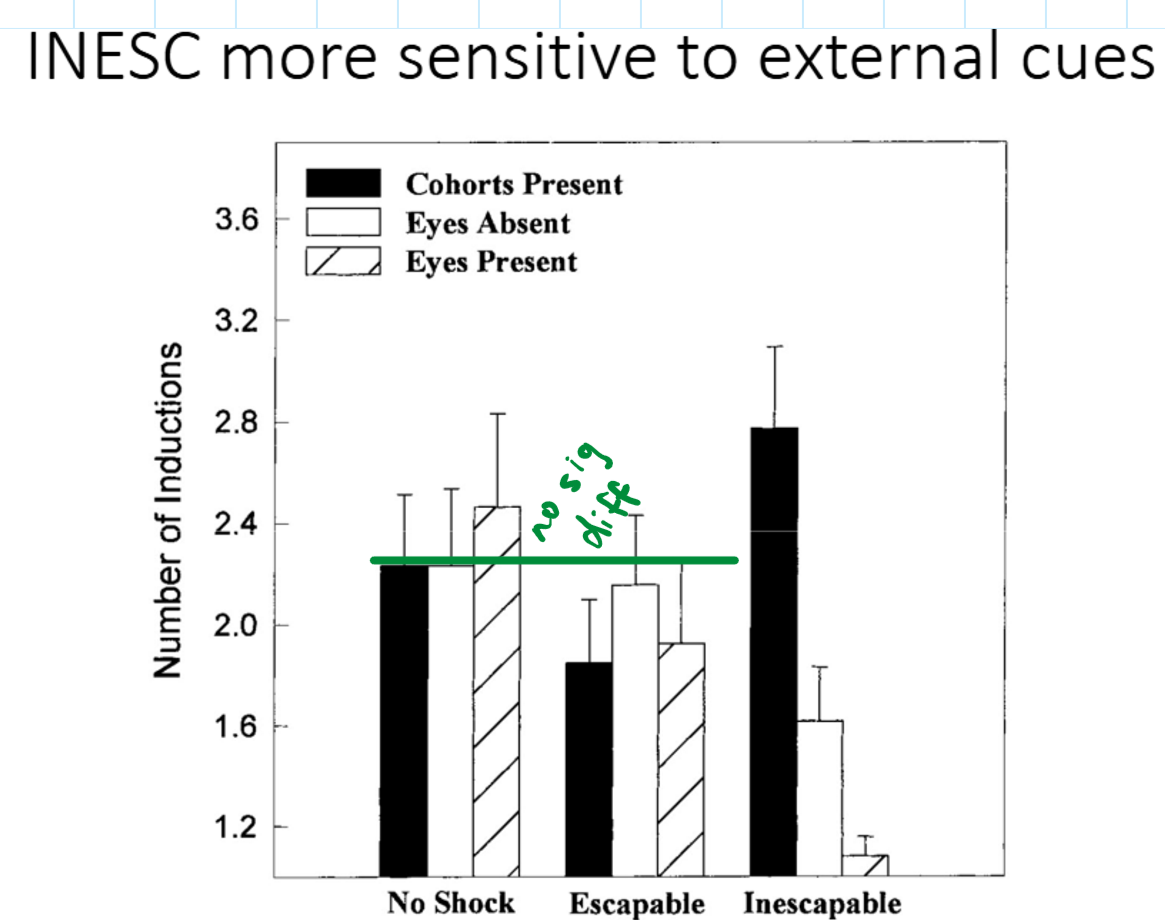
how whales mmanuplate sharks TI to get them
killer/orca whales that go after great white sharks
ram into shark (stun in) → use side fin of shark to turn shark onto its back (immobilize it/tonic immobility) → echo locate liver of great white shark to efficiently extract it → eat shark
Amygdala and Avoidance Learning - sugicall removing amgdala in monkeys
Surgical Conditions:
Amygdala removal (bilateral)
Inferior Temporal (IT) cortex removal
Sham surgery (control)
Task: Conditioned Avoidance Learning
Shuttlebox with electrified floor.
Light signals which side would deliver a shock.
Monkeys must move to the lighted side to avoid shock.
Extinction Phase:
Light still switched, but no shock given.
Findings:
Control monkeys (IT and sham): quickly learned and maintained avoidance (moved to light side).
Amygdala-lesioned monkeys:
Still learned the association (not amnesic), - But extinguished the avoidance behavior faster.
→ Conclusion: Amygdala plays an important role in maintaining learned fear and avoidance behaviors.
moneky w.o amgdala were slower to learn avoidance behaviour and quicker to extinguish it bc the dont feel that fear
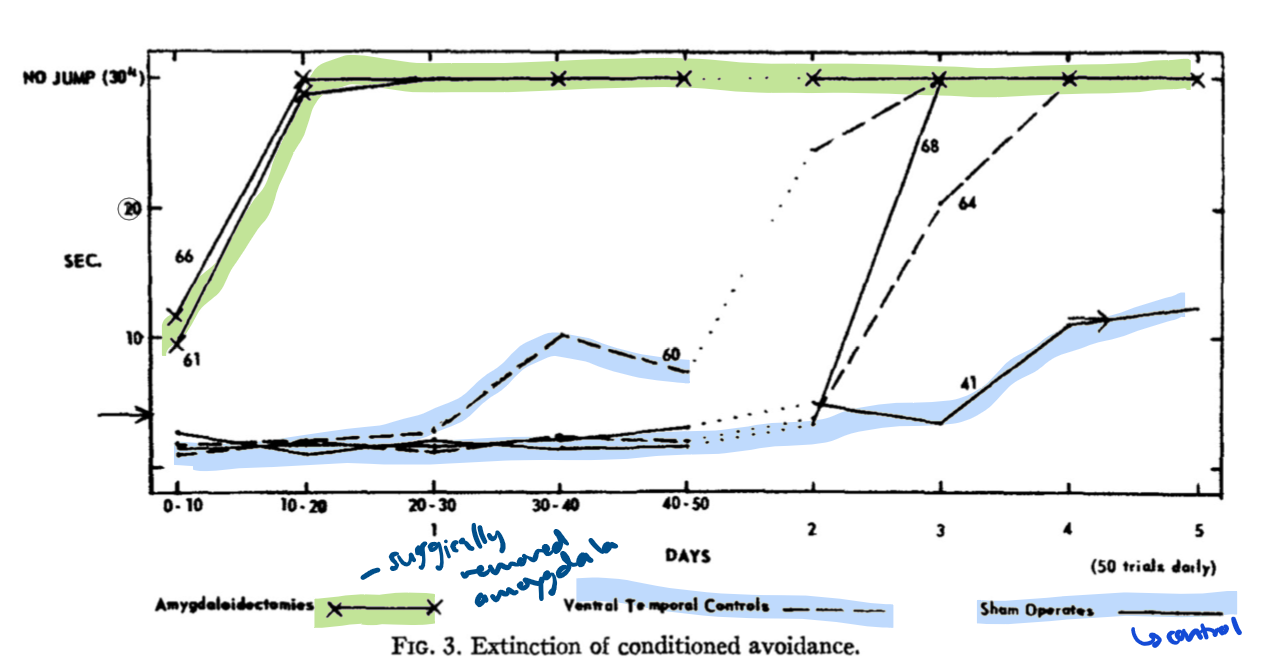
amygdala has many subnuclei that have diff roles
true
Avoidance learning is complex — includes (4)
Passive (freeze)
Active (escape)
Signaled (predictable)
Unsignaled (unpredictable)
what is usually first studied as part od studying avoidance behaviour?
using fear conditioning as the first step.
what is acustic startle reflex - how can it be enhanced
A rapid spinal reflex: ear twitch or whole-body freeze to a sudden sound.
Can be enhanced (potentiated) by pairing a neutral cue (light, odor) with a shock — a sign of learned fear.
can be used to learn about neurocircuitry involved in fear conditioning
train rat to pair sound with shock (pair with light as well), then when play just sound, it will react like its been shocked
once rat trained to expect shock w/ sound, startle amplified/potentiated
explain pathways involved in
Auditory signal → Thalamus → Lateral Nucleus (LN) of Amygdala
LN acts as the sensory interface.
Signal → Basolateral nucleus → Central nucleus of amygdala.
This produces Long-Term Potentiation (LTP) — strengthening of neural connections.
Contextual information (from hippocampus) also feeds into the lateral nucleus.
visual and aversive stim have projections/pathways to amygdala that can potentiate startle response
long term potentiation (LTP) - neuronal connection between thalamus and amygdala - direct pathway
thalamus, to cortex → has LTP response in coret → can go to hippocampus + amygdala - indirect pathway
neuron firing: release glutamate (Excitatory nuron) itno synapse → goes to post synaptic neuron ——--
Long-term potentiation (LTP) = Makes post-synaptic neuron fire more easily (depolarize)
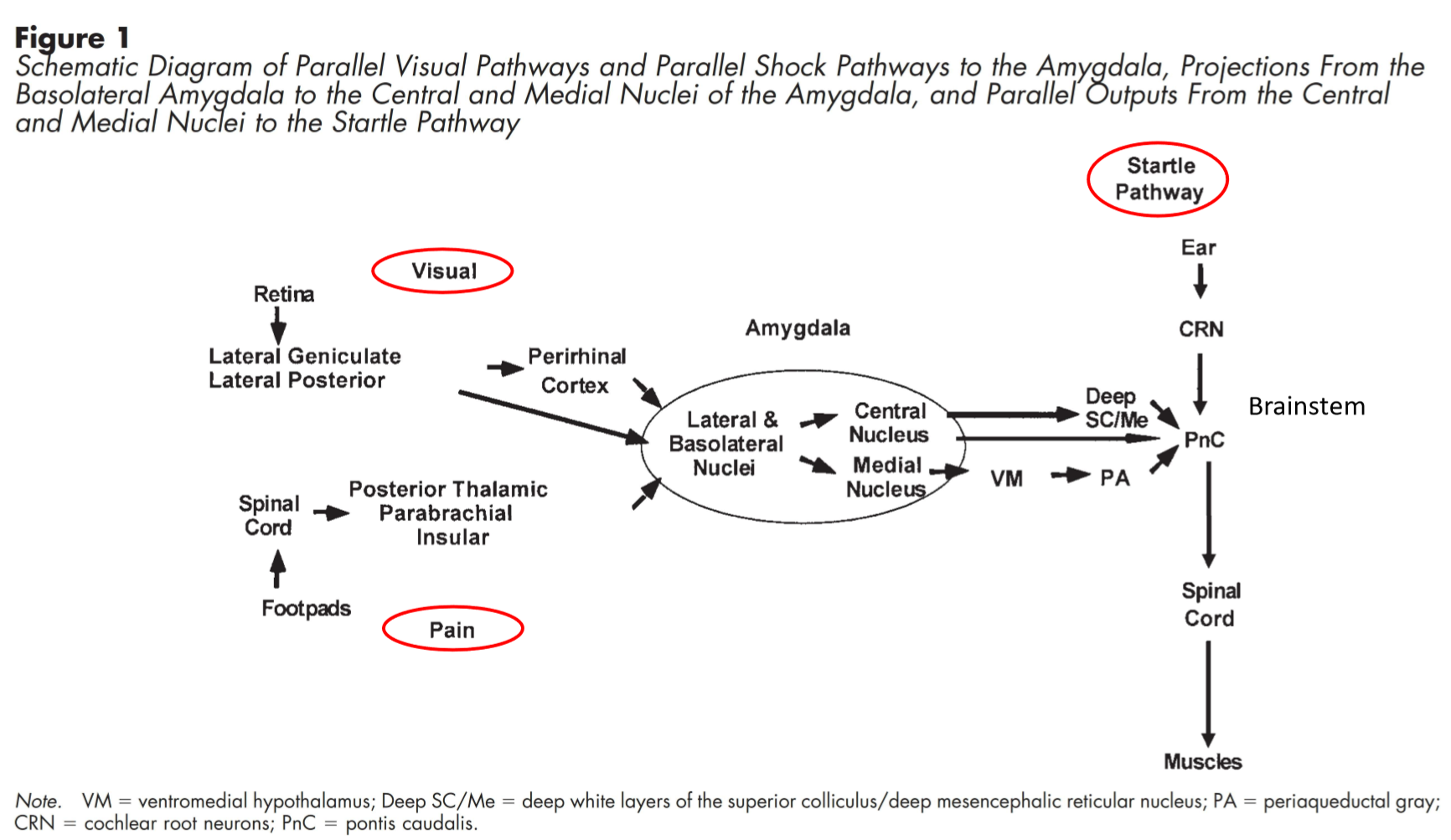
convetional belief vs new alt view of amgdyla role
conventional: Amygdala is responsible for the detecting of negative or threatening stimuli
Alternative view (Paul Whalen and colleagues):
The amygdala is involved in detecting unpredictable stimuli/uncertainty
ventral for detecting negative/harmful events
dorsal for detecting umpredicatbililty
Fear conditioning has both uncertainty (and unpredictability) as well as threat components
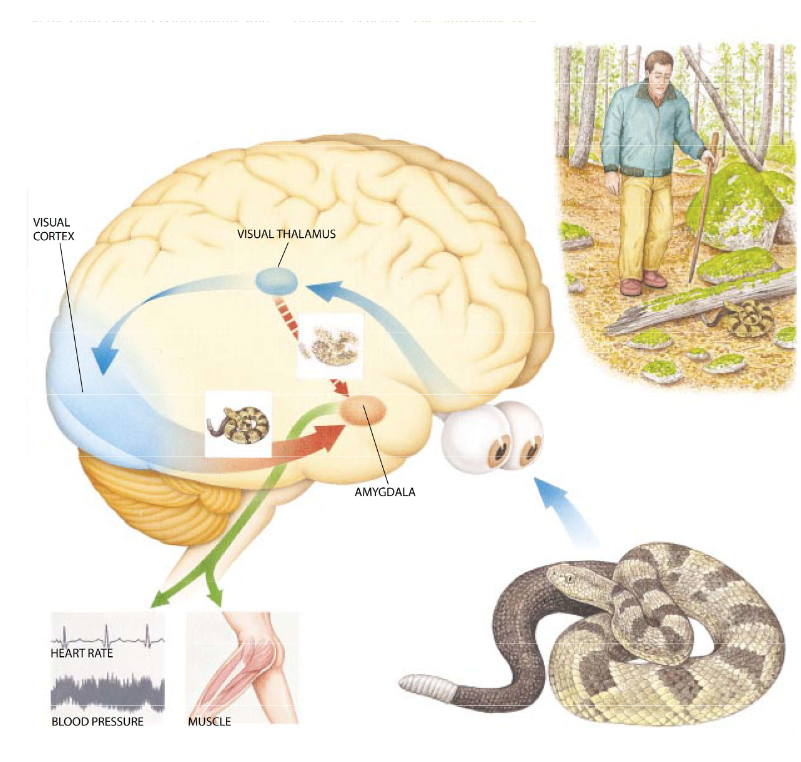
fear processing pathway with anagdyla ais rather than visual processing
explain indirect (slow) and direct (fast) pathways
Coretx pathway is slower process to help you understand the situation - indirect
Direct, Fast process is a separate pathway from visual/auditory input to the amygdala - processing fear and feeling it faster than you even process the situation entirely with the visual/auditory cortex
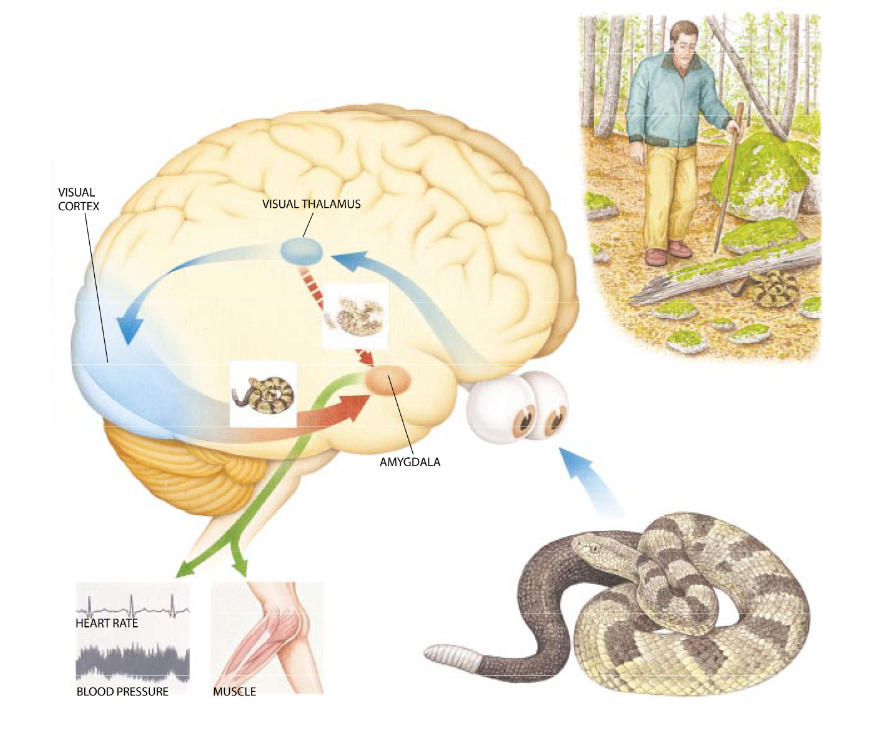
is suprise processed as a positive or negative emotion?
ventral amygdala (used for detecting negative/harmful stuff) exhibits less signal change for suprise like it does for fear facial expression - so deosnt see suprise as negative like it sees fear
also, dorsal amygdala (used for detecting upredicatbaility) sees no sigficant signaling siff between fear and suprise face
thus both dorsal and ventral amygdala doesn’t process suprise as a pos or negative thing
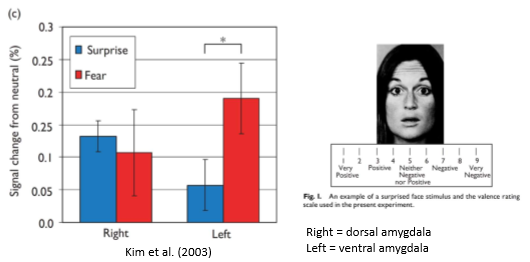
primate specalizations (4)
Convergent eyesockets - forward-facing eyes for depth perception
Enlarged brain
Grasping hands, feet
Visual specialization
whats is co-evolutionary hypotheses + the possible evolutionary drivers
coevolution = cases where two (or more) species reciprocally affect each other's evolution
possible evolutionary drivers:
Visual predation (detecting prey or predators)
Leaping through trees
Fruit and flower foraging (color and depth vision)
explain how fruits and better vision co evolved
explain leaping hypothesis coevolution
—
explain visual predation coevoluion hypothesis
Possible evolutionary drivers (co-evolutionary hypotheses):
Visual predation (detecting prey or predators)
Leaping through trees
Fruit and flower foraging (color and depth vision)
—
Main idea:
Leaping between tree branches required precise distance judgment and spatial awareness — driving the evolution of binocular vision and neural specialization for movement and balance.
Co-evolutionary logic:
Arboreal primates that leaped needed to gauge distances quickly and accurately.
→ This reinforced stereopsis (3D vision from overlapping visual fields).Strong grasping limbs and fine motor control also evolved alongside improved visual systems.
The vestibular (balance) and visual systems likely co-adapted to stabilize gaze and body position during motion.
Key co-evolutionary link:
Locomotion through trees ↔ need for precise depth perception ↔ selection for convergent eyes and visual brain expansion.
—
Main idea:
Early primates evolved forward-facing eyes, grasping hands, and sharp visual acuity to become better predators of small insects or prey in complex environments (like tree branches).
Co-evolutionary logic:
As early primates hunted small, fast prey, they needed depth perception to judge distances accurately.
→ This favored orbital convergence (forward-facing eyes → binocular vision).Hunting also required coordination of hand-eye movements, selecting for grasping hands and larger brains to process visual-motor information.
Thus, predatory behavior and visual anatomy evolved together.
Key co-evolutionary link:
Improved vision ↔ more successful hunting ↔ stronger selection for eye–hand coordination and neural control.
Constricting snakes caused early selection for (3)
Later, venemous snakes dorve further refinement fot (2)
Early constricting snakes likely drove selection for:
Orbital convergence (binocular vision)
Visual specialization
Larger brains
Later, venomous snakes drove further refinements in:
Visual processing systems
Cognitive functions
STUDY 1: do primates have innate fear of snakes
shown video where monkeys act scared of flowers or of snakes
interested in seeing if video of fearful responses affect subject’s behavior
did they learn to be scared from the video?
then told to reach into box (which is either flowers or snakes
they only get scared of snakes? the ones shown flower video doesn't get scared of flowers?
something innate about being scared of snakes
Findings
Monkeys developed a fear response to snakes but not flowers.
Demonstrates observational learning and biological preparedness — primates easily learn fear of snakes.
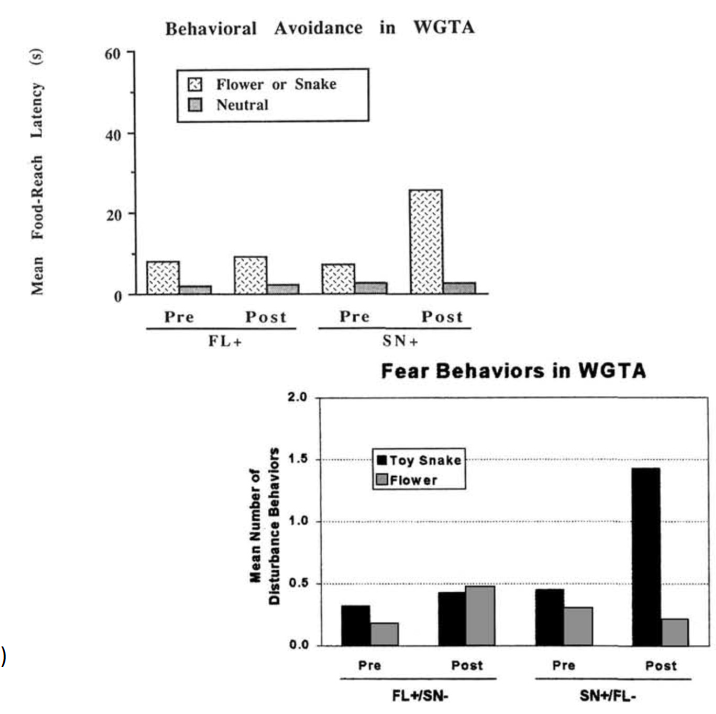
Major mammalian predators
snakes, raptors, carnivores
Snakes were likely the first key predators of small mammals
constrictive frist, then venomus
Constricting snakes selected for early visual/brain traits.
Venomous snakes refined these features in anthropoid primates (monkeys, apes, humans).
Fear conditioning often assessed with
acoustic startle pathway
visual and pain pathways
Visual pathway through LGN in thalamus, to amygdala
Pain through spinal cord and thalamus
Dedicated _________ is crucial to Sneddon’s pain pathway.
Dedicated neurocircuitry is crucial to Sneddon’s pain pathway.
Evolutionary time points
Summary
Constricting snakes > Mammals > Carnivores > Raptors > Venomous snakes, Anthropoids
Constricting snakes first predators of small mammals, including primates
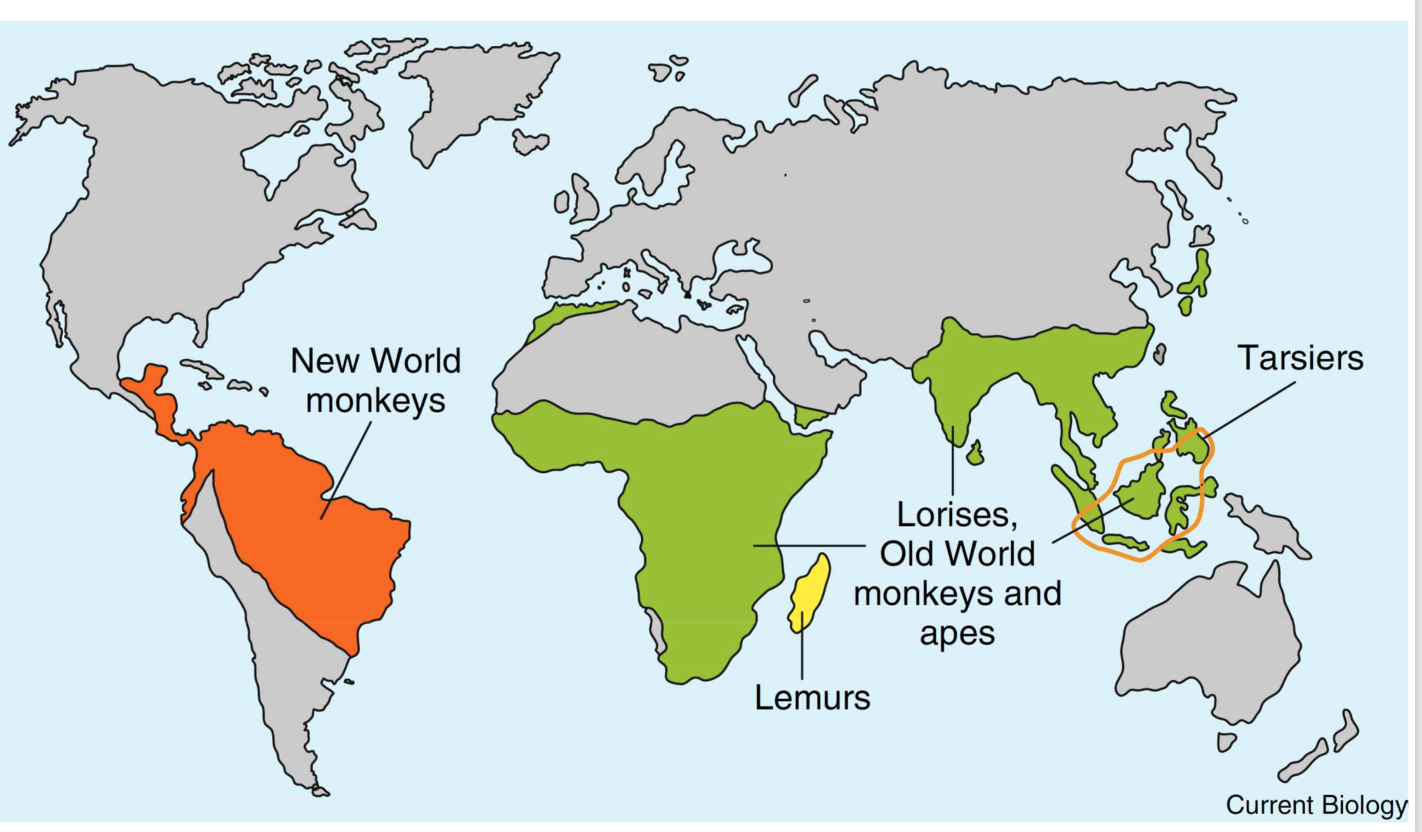
Which continent was exposed to constriction snake prey first consistently?
Which continent was exposed to constraining snakes intermittently?
Always - Africa (old world monkeys - catarrhini and apes/lorises)- most evolved visual system
Sometimes/intermittently - South America (new world monkeys - platyrrhini, baboons) - decently evolved visual system
takeaway: the types of predators (snakes) primates co-evolved with shaped their visual systems
Promisians are the ones without venomous snakes, new world were intermittently exposed, and the Cathyarine (human and associated primates) were always???????????
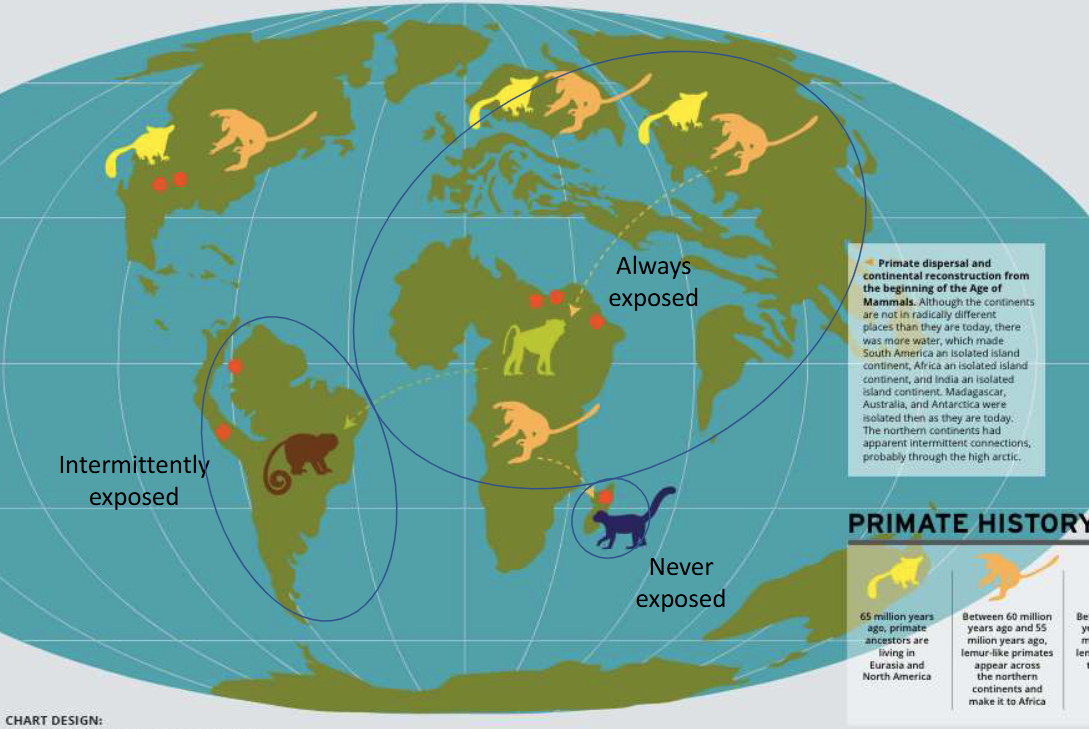
which monkey was nevr exposed to snakes and what did that result in?
lemures in Madagascar - less evolved visual system
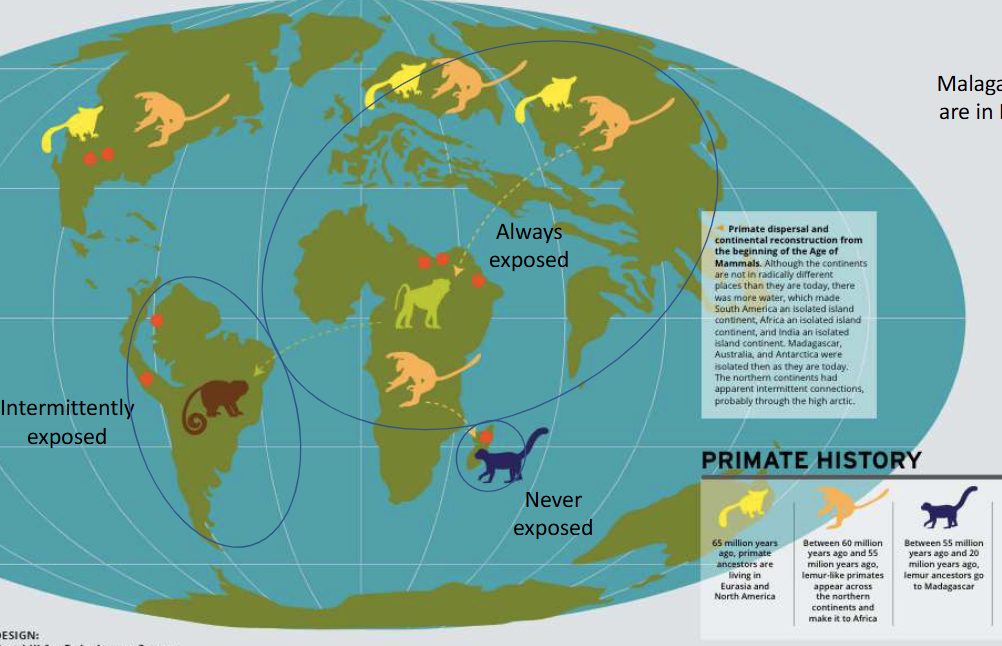
Brain Systems and Fear Detection (5)
1. Lateral Geniculate Nucleus (LGN) – Thalamus
Main Role: Detects threatening or negative visual stimuli.
Inputs:
Locus coeruleus (LC): Norepinephrine (arousal, stress)
Pulvinar: Visual relay nucleus
Inferotemporal cortex (IT): Visual recognition
Outputs:
Projects to central nucleus (CN) of the amygdala → controls fear-related motor behaviors
Evolutionary note: Structure largely unchanged across primate evolution.
2. Basolateral Nucleus (BN) of the Amygdala
Responsible for fear learning and memory
Enlarged in primates
Correlates with neocortex size → higher cognitive integration of fear
3. Locus Coeruleus (LC)
Central role in fear, stress, and arousal
Releases norepinephrine
Sends projections to:
Visual cortex
Thalamus
Amygdala
4. Superior Colliculus (SC)
Location: Midbrain
Layers:
Superficial: Visual processing
Deep: Motor/defensive responses
Functions:
Detects movement
Triggers defensive behaviors (e.g., freezing, darting)
Critical for predator detection and avoidance
5. LP–Pulvinar Complex (Thalamus)
Specialized in visual threat detection
Expanded in primates
Connects visual input to emotional and defensive systems
Two Major Visual Pathways in Primates (larger in primates than other mammals)
1. LGN System (Conscious Vision)
Pathway: Retina → LGN → V1 (Primary Visual Cortex) → Extrastriate Areas
Function: Detailed, conscious visual perception
Types of LGN Cells: two spots more crucial to vision for perception (P and K) are expanded...to detect threats
Parvocellular - perception/visual processing of colour and detail
Koniocellular - connect retina to SC and pulvinar to LGN - needed for pre-attentive detection of fear-related stim. - related to blindsight
Magnocellular - detect movement and contrast
2. SC–Pulvinar System (Rapid Threat Detection)
Two branches:
Retina → SC → LGN → V1
Retina → Pulvinar → V1/V2
Function:
Fast, pre-conscious detection of threats (e.g., snakes)
Evolutionary advantage: Enables quick survival responses
pulvinar is expanded in primates!!!
Primate Adaptations:
Larger visual systems
Enhanced central (sharp) vision
Better color and fine-detail discrimination
Faster attention to salient (important) stimuli
Pain goes through multiple pathways: thalamus, hippocampus and cortex. - hippocampus and cortex suggests some processing
There are two systems in primates: LGN and SC-Pulvinar
Takeaway: Primates have two additional branches of the visual system that pass through key areas of the brain involved in processing fear. They are Larger in primates thus proves they are helpful and selected for
the _______ is expanded in primates -
the pulvinar is expanded in primates
Lesions to _____severely impair primate & anthropoid vision, but not rodents
Lesions to V1 severely impair primate & anthropoid vision, but not rodents
V1 is in the visual cortex within the_____ lobe. If you took out a chunk, you’d see there’s different types of _____cells
V1 is in the visual cortex within the occipital lobe. If you took out a chunk, you’d see there’s different types of LGN cells
You can have an ability to detect snakes without conscious awareness.
blindsight
what is it
what LGN cell is it related to
how does it happen
how can we mimic this and what does it show
can detect but not consciously see visual stimuli.
koniocellular LGN cells
when you have V1 lesion - P cells degenerate, but K cells remain active
Shown via backward masking (very brief, unseen images) - shows that V1 necessary for conscious awareness of snakes, but not detection.
Suggests unconscious snake detection may have been vital for primate survival.
Snake Detection and the SC–Pulvinar Pathway
SC, LC, Amygdala, Pulvinar work together for pre-attentive (automatic) fear detection.
K cells are especially important—they connect retina → SC → LGN.
This SC–Pulvinar system may be specialized for snake detection.
Dorsal and medial regions of the pulvinar are novel to primates - 745 firing pattersn fro pulvinar neurons
More neurons responded to snake images
Stronger and faster responses to snakes vs other stimuli
Indicates a specialized neural bias for snake detection.
Pulvinar neurons responded most strongly when snakes were in striking position.
In humans, snake skin patterns evoke stronger early posterior negativity (EPN) than lizard or bird patterns.
Neurons can rapidly segregate out snakes from images of hands and monkey
As time goes on, the hands and monkeys are separated too, but it’s the snakes that got separated first
EPN = EEG signal linked to emotionally significant stimuli.
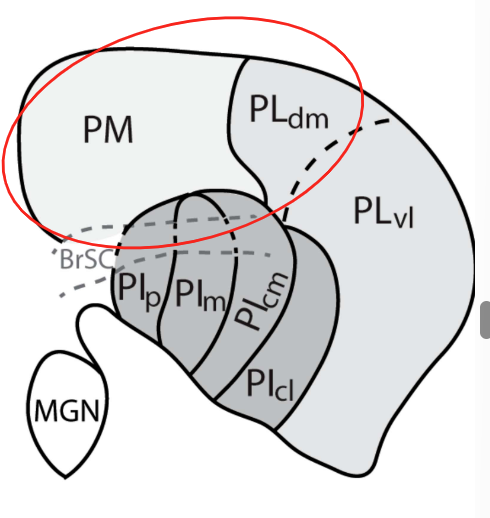
Crown group mammals
how did snake preaying upo vrown group ancestor influence decendants
Crown group mammals: all living mammals + their common ancestor.
Snakes preyed on the crown group ancestor to make the ancestor fear snakes, influencing all descendants to fear snakes.
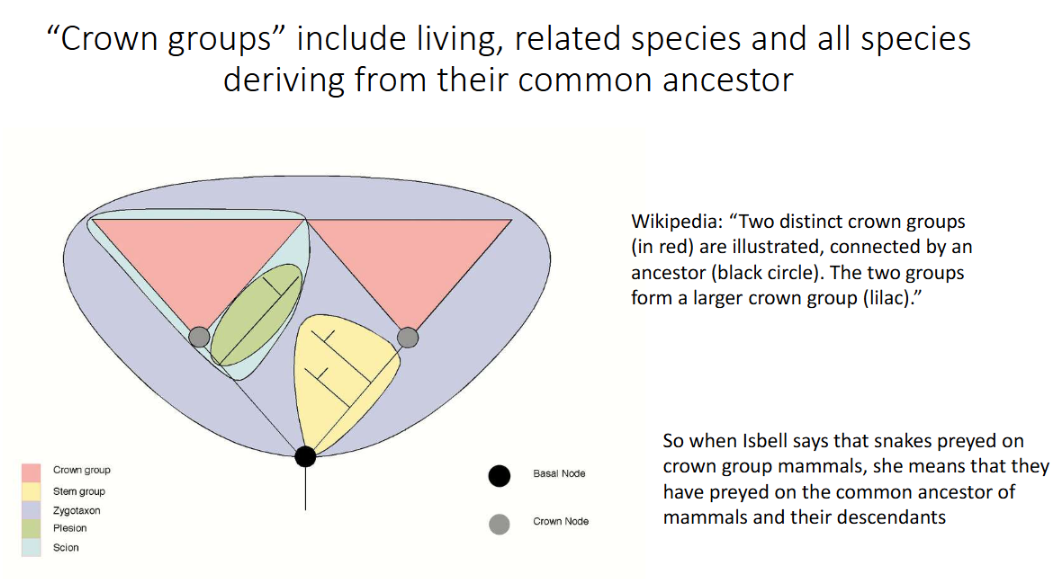
owl and primates evolved to btoh have convergent eyes bc
promotes stereopsis (depth perception) —> to prey on snakes
visual specialization came at the cost of olfaction (smell)
Overview
Cytochrome Oxidase (CO):
An enzyme marker indicating metabolic (energy) activity in the brain.
High CO levels = regions with high energy demand (active neural processing).
Location in the Visual System
Found in:
CO blobs in V1 (primary visual cortex)
CO stripes in V2 (secondary visual cortex)
These structures are critical for color, depth, and object processing
Neural Connections
Koniocellular (K) cells project directly to CO blobs.
→ Integrate motion, color, and threat-related cues within early visual processing.
Co-evolution with Diet
Fruit-eating primates:
Have larger Parvocellular (P) pathways and larger brains.
Needed precise color and spatial vision to identify ripe fruits among foliage.
Fruiting diet supplied sugars (energy) to power metabolically expensive visual systems.
Key Takeaway
CO density reflects how visually specialized a primate is.
Catarrhines show the most developed visual cortex because fruit-rich diets and predator pressure supported evolution of high-energy, high-resolution vision.
